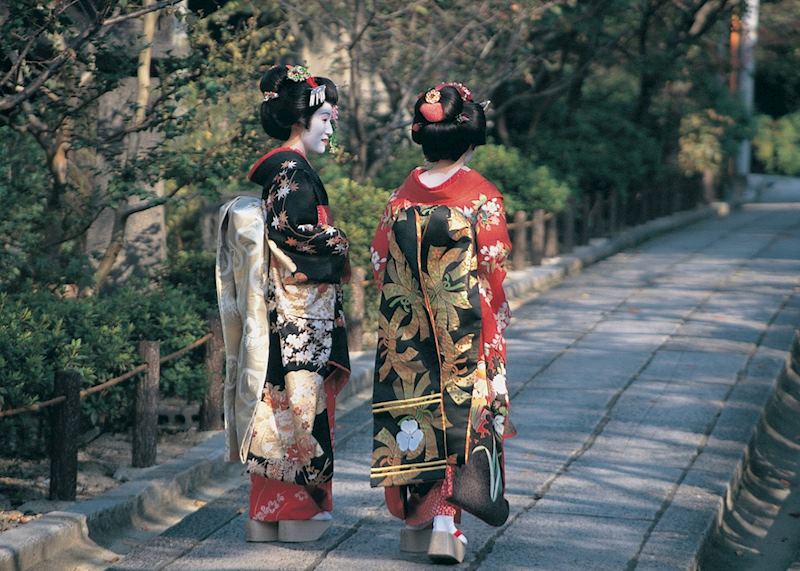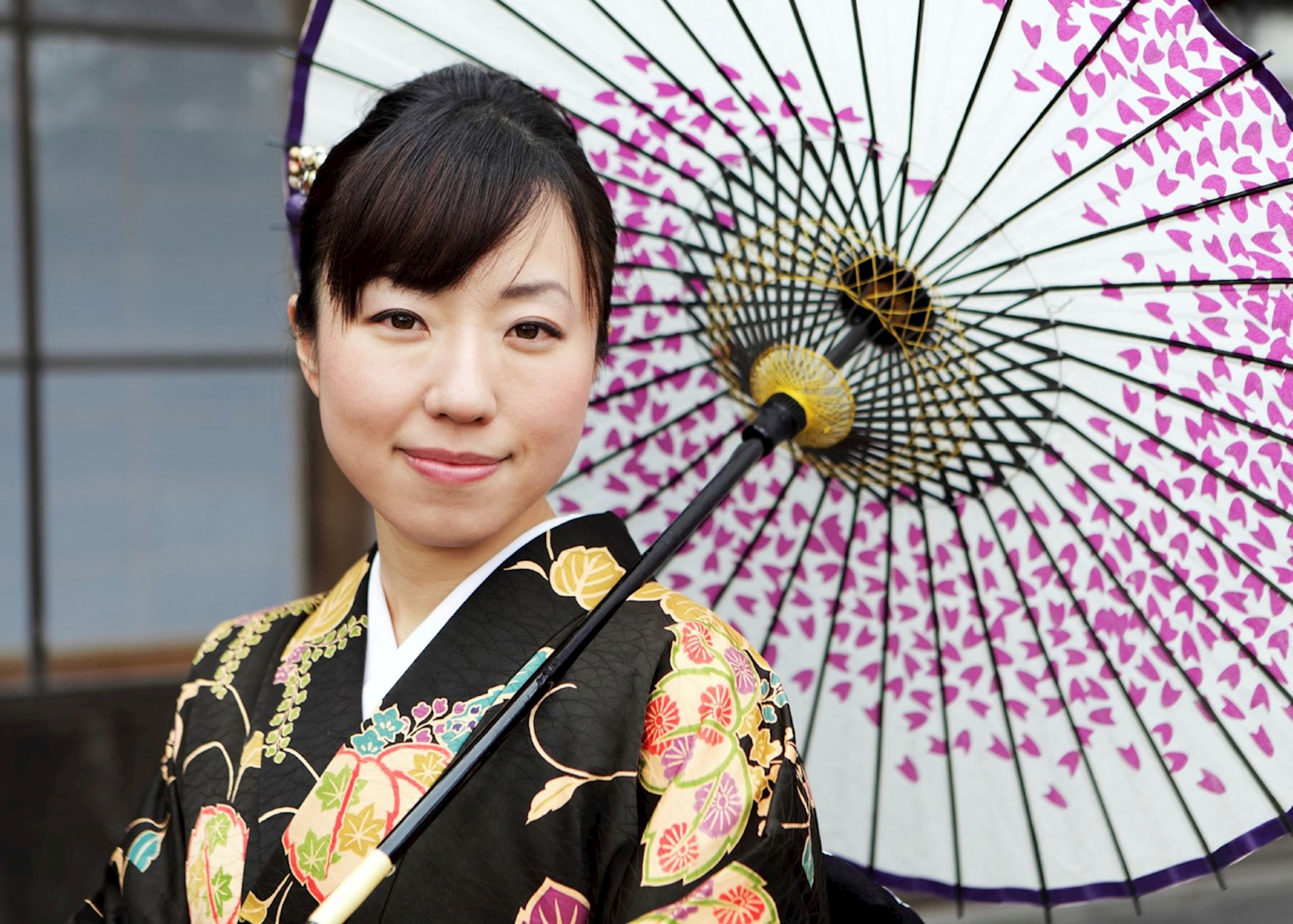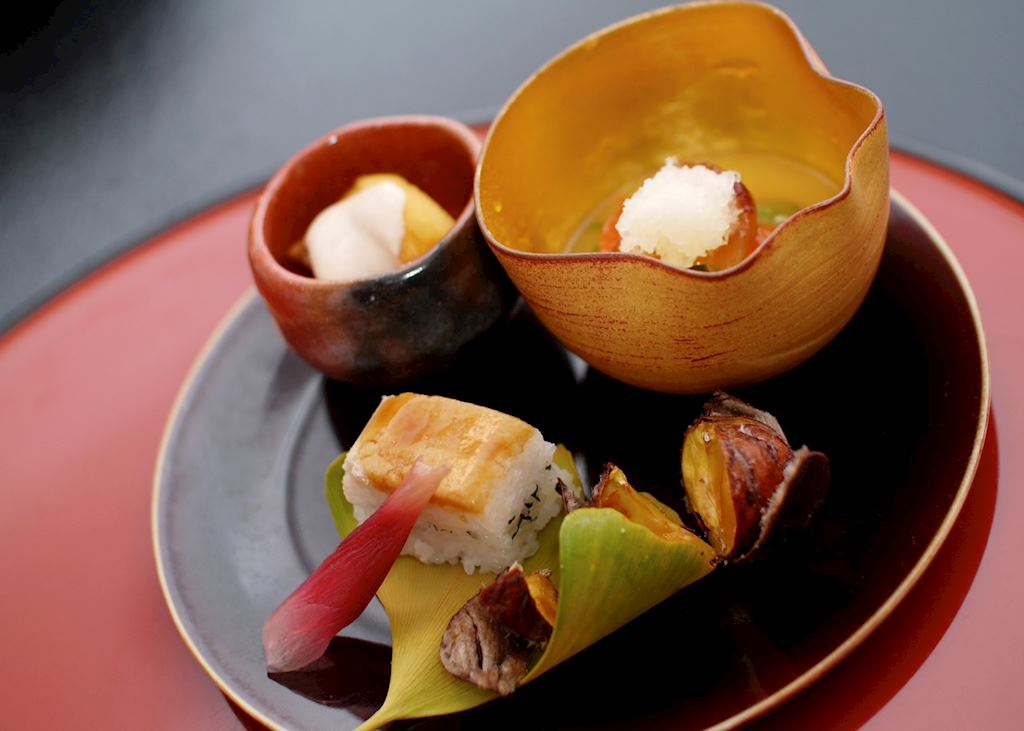Getting under the skin of a culture and really getting to know the people is challenging anywhere in a two to three week trip. This is especially the case in Japan, with traditional reserve sometimes holding people back. Here Lyn Hughes, Editor-in-Chief of Wanderlust magazine, experiences a great way to get to know the locals a little better — all whilst learning a new style of cooking!

A light rain was falling as the parasol bobbed through the crowd, the geisha beneath walking in her purposeful way through the hordes thronging the Gion district of Kyoto. My guide, Duncan, reminded me that we had seen this particular geiko, as the geisha are known locally, earlier when she was on her way to an appointment in a traditional teahouse.
Duncan is a freelance translator who also works with Audley, and is an ideal guide to the mysterious world of the geisha. A walk around Gion with him was a fascinating insight into a different and somewhat impenetrable world. It was a far cry from the city centre, where young professional types sipped their lattes in Starbucks, and where the newly-opened Krispy Kreme Doughnut outlet, attracted a huge queue.
It was this paradox that leaves you wanting to know more about the people, and about everyday life in Japan. Everyone was polite and helpful, but it is always difficult to really get to know anyone when staying in a big city. Food can be a real key to a culture, and so when Audley suggested a ‘sushi and tempura’ home cooking course as part of my stay, it seemed to be the ideal solution to meet some locals.
Admittedly, I’ve never really got sushi. Yes, I’d occasionally buy it from a supermarket as an alternative to a sandwich, but I couldn’t really understand the appeal. Meanwhile, my experience of tempura was of soggy vegetables covered in a greasy batter. However, I was open to being converted.
It was a two and half hour course, to include lunch, at the home of a local housewife. Kyoko is a bustling lady who offered us a cup of tea before she got stuck into making a stock, explaining this is always the first job of the day, and would form the basis for miso soup as well as being used for other dishes. She adds kelp to water and brings it to the boil, then removes the kelp and throws in bonito flakes.

Kyoko cheerfully multitasked, showing us how to make a savoury pancake called okonomiyaki, filling it with cabbage, mayonnaise and bonito flakes. Meanwhile, she started grinding rice in a grinder, until it came out a gleaming white.
“Japanese cooking is very simple!” she exclaimed, talking us through the base ingredients for most Japanese food; sugar, salt, rice vinegar, miso paste, sake, light soy, dark soy. As she blanched some spinach, immediately reviving it in cold water to keep it green, she explained how important the look of the food is too in Japanese culture.
Tea drunk, she then got my friend and I onto making the actual sushi. A special pan was used to make a perfectly rectangular omelette, and we soon got the knack of that to much praise from Kyoko. Next, nori leaves were laid on a mat, and we added warm rice and omelette, and then toppings of cucumber lengths, egg, crabsticks (“invented by the Japanese”) and eel. We rolled the mat up, squeezed and turned out a roll of sushi which was then neatly sliced. We puffed our chests out in pride at the professional-looking sushi.

Meanwhile, Kyoko demonstrated how she made fresh batter for the tempura, using ice cubes. “Only stir it briefly,” Kyoko stressed. She then made a savoury egg custard, straining the eggs “to make them shinier” before mixing them with a bit of broth and pouring the mix over some artfully arranged mushrooms, prawns and wheat gluten in bowls.
Eventually we sat down for lunch, frying the tempura at the table, sampling our sushi, and tasting Kyoko’s miso soup and egg custards. Everything was fresh, and looked beautiful. We felt positively virtuous.
Although the cooking was fun, the real joy of the morning had been to be in a local’s home, to witness everyday life in Kyoto, and to have the opportunity to ask about each other’s lives. There was much that was familiar in Kyoko’s kitchen, including a microwave. But, little touches were alien, such as the fact that she used chopsticks for stirring, not a wooden spoon. And, rather than using a chopping board, she would use the cardboard wrapping from used cereal boxes as a base.
The course was one of the cultural experiences offered by the Women's Association of Kyoto (WAK), an organisation that was founded in 1997 by a woman called Michi Ogawa who, having spent some time living in France, appreciated how difficult but rewarding it can be to understand a very different culture. She also saw the opportunity to provide housewives with ways to demonstrate their skills and be appreciated.
Today WAK offers a variety of courses, either in its headquarters, or in people’s homes. I also signed up for a go at calligraphy (sadly, I’m not a natural!) and at kimono-wearing, as well as sake-tasting in a traditional former brewery. But the home cooking was definitely the most memorable as it gave an insight into a typical Japanese home.
I must admit that it had also been a relief to find that not every toilet in Japan had a heated seat and needed a user manual and an engineering degree to use. But that’s a different story!
Meet the Guides
 Being brought up in the West can mean that it is difficult to relate to a culture as different as Japan's. Language difficulties, even with many Japanese people fluent in English, can make it tricky to explain things in a way that makes sense in the context of a British upbringing.
Being brought up in the West can mean that it is difficult to relate to a culture as different as Japan's. Language difficulties, even with many Japanese people fluent in English, can make it tricky to explain things in a way that makes sense in the context of a British upbringing.
Duncan and Izumi make this easy for visitors. Kyoto residents who have been working with Audley clients since 2005, both have Japanese and English parents and work as translators. Izumi grew up in Spain so also speaks fluent Spanish! Having been raised by mixed parents, they not only speak two languages as native speakers, but are uniquely placed to explain one culture in a way that makes sense to the other. They have lived in Kyoto for over ten years and know the city intimately.
Taking an evening geisha walk with them, through Kyoto’s traditional Gion district, you’re not only more likely to spot some of the elusive geisha, but will also get a deeper understanding of their traditions, their place in Japanese culture and the motivations of the young girls who give up so much in order to become geisha.
Was this useful?






